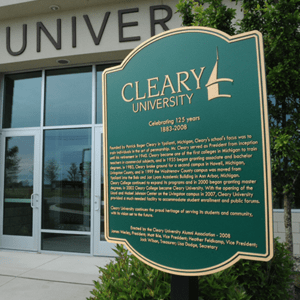
College campuses are looking quite a bit different from the way our parents and grandparents experienced them, not least of which is due to the growing diversity of Generation Z, or the post-millennial generation that fills our campuses today.
In fact, a 2018 Pew Research Center analysis of Census Bureau data found that this generation is the most racially and ethnically diverse of all American generations to date. Just slightly more than half of 6- to 21-year-olds are non-Hispanic whites.
And, the analysis found, that older post-Millennials are enrolling in college at a much higher rate than Millennials were at the same time in their lives.

This prepares the leaders of tomorrow to “ create a new business landscape,” says David Hayes, Cleary University Dean of Undergraduate Studies. “That’s the whole goal.”
“The business landscape for a long time has been cannibalistic and dog-eat-dog,” Hayes says. “This generation of students is changing things. Exchanging ideas among diverse populations is allowing them to create a new business landscape, that is more relational and human – and more successful.”
Cleary’s “intimate” setting lays a foundation for true interaction with students and faculty every day, Hayes says. That includes personal interactions with instructors, who also hail from diverse communities. “It’s enlightening,” Hayes notes. When “you’re not just a number,” the ways you look at the world become known and influence and inspire those around you.

The Myths of Gen Z
Older generations assume things about Millennials and Gen Z, which are not borne out in fact. With Cleary University now being led by a Millennial President (Emily Barnes), it’s imperative to understand the strengths and assets that these younger populations bring not only to the business landscape, but to the world.
⁉️ Myth: They only communicate via screens.
☑️ Truth: While that’s a viable form of communication for these generations, they are equally adept at face-to-face conversation, Hayes says. What’s more, they see ALL forms of communication as EQUAL and impactful.

“They believe that electronic communication is equally as real as a face-to-face conversation,” Hayes notes. “If you’re interrupting a Snapchat conversation, you’re interrupting a conversation. They are far more adept at different modes of communication than older generations tend to be.”
⁉️ Myth: They know ALL forms of technologically.
☑️ Truth: Gen-Zers are actually technologically behind in some ways.
“They don’t know how a lot of things work – like email. It’s far harder for a Gen-Zer to attach a document to an email than to stream a show or do instant communication. Being able to manipulate something or troubleshoot it is way beyond the pale. They need a lot of technological training.”
⁉️ Myth: They’re too outspoken, all the time.

☑️ Truth: Generation Z are a product of school systems where they were told “to sit down and shut up,” Hayes says. “We have to break these habits, and they’re very hard to break. This generation is deathly afraid of being wrong because the consequences of being wrong resulted in not being able to play their sport or being chastised. It’s reinforced in media where a celebrity or politician isn’t allowed to change their mind with new information.”
At Cleary, we are training students “that this is the place to fail. They have permission to fail – because when you mess up, you figure out how it’s supposed to be. We’re working on getting Gen Z to try new things, figure out how they work, and be willing to try even if though you might mess it up,” Hayes says.

⁉ Myth: Gen Z is totally and completely accepting of all ideas.
☑️ Truth: While this generation is far more idealistic than earlier generations, they have a confirmation bias from omission.
It isn’t that they don’t want to see differences but, as Hayes notes. “In a human resources class, for example, when faced with a sexism scenario, they don’t want to believe it exists because they haven’t ever experienced it in real life.”



